I am Patrick Wong. I received my early education at Hong Kong and immigrated to Canada back in 1989. I am now living in Toronto and is working for Bell Mobility Cellular as a R.F.analyst. My prime job is to maintain network quality of our cellular service in Toronto and selective parts of Ontario.
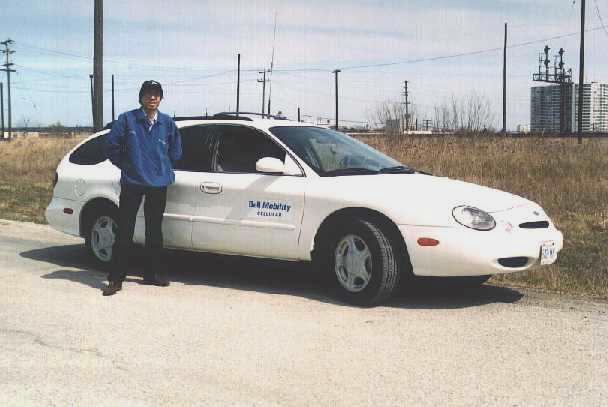
My war horse (Porcupine)
My background.
I worked for Cable and Wireless (HK) Ltd. before moving to Canada. Cable and Wireless (HK) was the sole international carrier organization at Hong Kong during those time. She provided the links via satellite, sub-marine cable, tropo-scatter technology and even high frequency radio platforms. I last served in her IDTC ( International Data Testing Center ). Being a newly developed function at that time, my work used to look after quality acceptance of newly commissioned data circuits under 2.048Mbps range. That's where I gained my job experience with data communication and its related technology.
I always admire radio communication. One of the reasons why I joined Cable and Wireless right after I left my middle school education was partly because of my interest in telecommunication - especially radio transceivers. I didn't have a clue that it ends up with spending my later 15 years looking after data and switching circuits. But anyhow, there are other seniors in the organization who are amateur radio operators. I got the information on what to study and how to sit for the examination. I got my license at 1977, call sign VS6GW.
It was back in 1987 when I first heard about Internet. I must admit that I didn't know clearly what its real power could be at that time. To me, it was just another high speed circuit for some of our high profile users. Internet Email was limited between Universities and certain foreign government organizations. What normal user can access at that time similar to such function were amateur radio packet and hobby BBS network. For non-ham readers, amateur packet is a private network supported by amateur radio stations all over the world. Unlike international Emaill exchange in hobby BBS which normally involved certain amount of subscription, amateur packet network is free. We relied on AX-25 protocol which is a modified X25 packet protocol for two way radio. These networks are still in operation. There are usually at least one host station serving a major city. General configuration is a personal microcomputer hooked up with a TNC (terminal node controller). Such TNC will control contact with two radio networks. A short wave network to connect outside world and a UHF or VHF network to serve local users in the same city. Emails left in the host by local users are forwarded to foreign host via short wave. The distant target receiver then pick up the mail via his local network. With good efficiency, a message from south east Asia can reach USA in about 7 hours.
My daily work.
Communication is my profession and is also my hobby. It is really a fortune that my current job is deeply R.F. related. I have my early years in Bell Mobility as a cell site technician and looked after an average of 8-12 cell sites. Our prime job include diagnose, repair and line up of hardware. We are front line staffs who have to perform initial diagnose on a site in case it went down. In order to provide quicker response time, manpower and parts, we took the company vehicle home which is in fact our mobile office. Four or five years ago (before most hardware were fully debugged), we tends to have lots of mid-night calls for fixing problems. It could be a call to bring back a failed CSC (cell site controllers), dead microwave hop or fiber link. We even got called to investigate high temperature alerts (faulty air conditioner). We might not be expert in everything, but we are the ones who have to come up with a solution to improve or secure a situation when something gone wrong at a cell site.
Being an R.F. analyst, I no longer look after maintenance of cell sites. Instead, I am now responsible for maintaining the mutual balance between their performance. The job includes constant tracking of our network's performance via various sources of information - system's logs, billing management data, user's complaint, real time data collected from remote road tests and coverage plot… etc.. As a result, I have to trade part of my freedom in the field to start building up some keyboard time behind the system monitor. I still work a lot in the field to perform audit on the hardware platform and the actual R.F. coverage. If you take a close look on the first picture, you might be surprised on the number of antennas on my vehicle - totally 9 antennas. With the test phones in my vehicle, I can collect service quality information of our platform or log in the central computer and perform remote maintenance activities. R.F.coverage data together with corresponding geo-positioning data can then be recorded and be studied later.
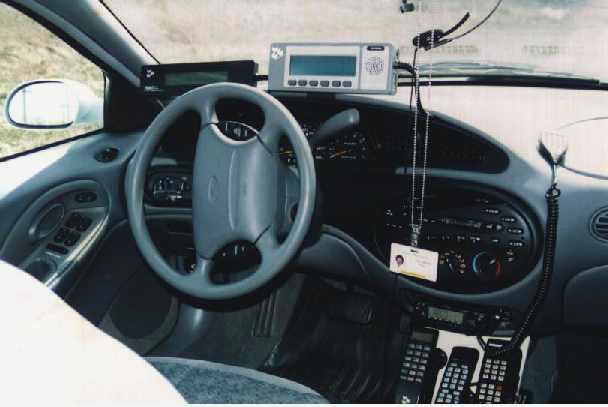
Cockpit of my mobile office
Due to complexity of our current network, it takes a lot of effort and a very dedicated work team to ensure its running smoothly. One of our problems is the rapidly growing user base. Public telephone networks are usually designed on a sharing factor. It is a compromise between total number of available voice channel in the network verses how many users might use the phone at the same time. If prediction on this sharing factor is under the actual network growth while systems is running short on channel resources, user will encounter severe blocking. The fault will appear as connection deny in the form of "busy signal" or "user not available". For AMPS cellular industry, we have an extra enemy called co-channel interference. It is the result of over-sized coverage when signals of users using the same frequency (under re-use concept), runs into each other due to un-expected propagation. This causes cross talk, static noise, jamming tone or even pre-mature termination of a call. We first run our sites with omni coverage pattern. In order to improve the ability to fight against this problem, we brought in 120 degree sectored coverage. To beat capacity limitation, we move into 60 degree sectored coverage since 1990.
Before adding new voice channels, we need to reduce coverage of neighbor sites first. This is to obtain clearance between the new members and their co-channel partners. Radio coverage can be predicted but that is based on a known start point of emission. We can predict on coverage pattern of a site after knowing its location, antenna nature, terrain blocking and reflection. Yet it is not that easy to predict coverage of a site's users since there are just too much combination on where they can be located. I'd once come across a case which one of our users complained on getting roaming charges from U.S.A. carrier while he had never left Toronto. As we investigated the case and paid a visit to his house, we found that he uses his phone mainly at his balcony. He is completely open towards the lake and higher then our nearest cell site. The signal of his phone can be heard at state's carrier at Niagarra area. Once that happened and a clear house message sent back to us (his home registered provider), he is considered to be a roamer at the other side. If some one called him, the call will be forwarded to USA and serve him from a USA site at Niagarra - paying long distance for a crap call !! We fixed this case with a coffee can. Email me for more detail if you are really interested to know the story.
We are very glad to see that our product first appeared as a symbol of expensive high technology but finally became an essential part of the general public. Mobile phones provide new options to daily life and changed the society's operating pattern. Demands from users invoked development of better technology. That further enhances such impact. We made our trial on TDMA (digital) but finally changed to deploy CDMA because it has a far better potential for further development. It is a constant battle between capacity and quality but I have no regret to be part of it. It is the challenge making the job so interesting.
My hobby involvement.
I had been quite crazy on motorbike once upon a time. It is not easy to own a car in Hong Kong. The cost is high on parking lot and vehicle license. But it seemed immature to be without driving skill also. Just for joke, car is a must ( 4C theory - care, camera, car, cash ) to improve your strategic position during working out of a date. Even though we all bulls that be married is a big mistake, we all jumped into the same pool and work out somewhat the same route towards maturity. During those days, learn-permit for driving a car and riding a bike are granted at the same time. It seemed a waste on the un-used portion of the permit. So, I searched in the newspaper private sale area and picked up a Honda 175c.c. at a minimum cost. With a "Learn" plate flipping in front and behind, I drove solo during dedicated time frame which covered trips between office and home. I can even enjoy visiting areas beyond normal reach sometimes. This increased immediately my activity territory. I really loved the freedom that little bike provided me. After I got my license on both platforms, I gradually go for higher power bikes. I still missed my last vehicle - a Honda CB750F. I might turn my interest to ride snow mobiles if my other half stopped her protest !!
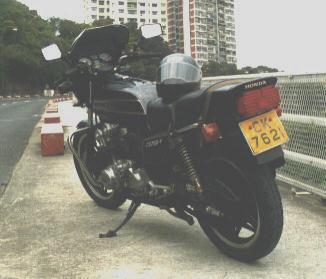
CB-750F 1989
Ham is a life long hobby and I am happy to be part of this great family. It was back in 1975 when I knew more detail about the world of amateur radio besides citizen band radio. Ham radio in Hong Kong was very low profile during that time. Operators were mainly visiting officers in British military services, airline captains and high professionals. There were very few active Chinese operators. In fact, amateur radio operators at that time must be of British subject. This limitation discouraged a lot of fully qualified professionals with Chinese nationality. All hams were members of a friendly society called HARTS ( Hong Kong Amateur Radio Transmitting Society ). We used to get together every Tuesday at the China Fleet Club and have an official meeting once a month among the 30 active members. The meeting was usually followed by a small banquet at the Peking restaurant "America". It was surprising on how the foreign members know about traditional Chinese foods. They probably knew more about those northern style dishes then me.
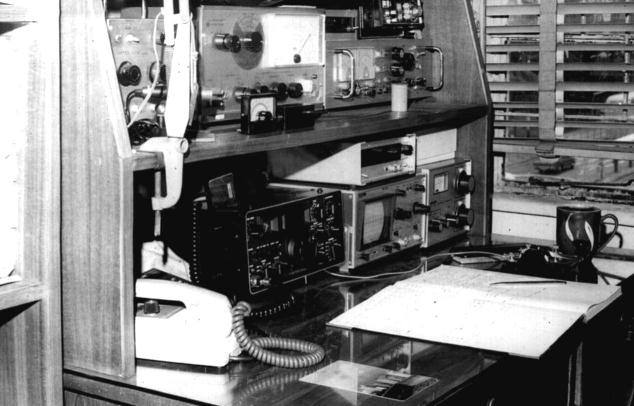 …
…
VS6GW 1978
The real fun started after I'd got my first VHF radio. We did not have repeaters but we had a bunch of Cantonese speaking operators. We used to meet in a morning net when everybody started for work. One of them is an important character who changed me - Dr.Antony Lo (VS6AQ). He is energetic and a born leader. One of his famous saying - let's do it. Members of this morning net made 1978 a very colorful year for HARTS. We ran for the executive committee and got two seats (hon. secretary and QSL manager). We promoted visibility of amateur radio in Hong Kong's communities. With the help of other VS6 ham operators, we supported international communication for various community functions. We also assisted to form four important club stations - including the club station of HK junior police call, boys scout, Kwuntong polytechnics and La Sa College. We supervised their initial operation and guided their operators to get their license. We wrote articles in the Chinese radio magazines and attracted a lot of local members. The key result - HARTS became more open to Hong Kong local citizens ever then before. Within 7 years, under constant request and other factors, there came two more important changes in VS6 licensing. First issue being the open up of class B license (while holders are limited to operate on bands above 30MHz only). The second issue being acceptance of applicants with Chinese nationality. These two factors created the huge expansion in VS6 population. By the time when I left Hong Kong, we have about 360 active operators (compared to about 30 when I joined back at 1976).
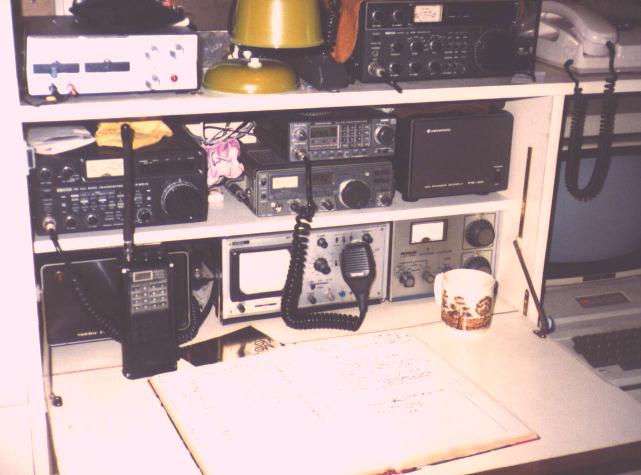
VS6GW 1985
The QSL manager post in 1978 forced me to meet people (especially foreign contacts and QSL managers outside Hong Kong). That's the first time when I learned about general structure of legal society and how to conduct business within international public body. All these activities greatly improved my foreign language and exposure to western civilization. I used to be a quiet character and tends to follow the flow. Yet Anthony's direct approach style somehow got into my behavior. I tasted that one has to stand up and fight for what he feels right. One can be wrong, he might have to take up the responsibility of his error but he cannot be indecisive. One cannot be a follower if he felt his beloved majority is on the wrong track. One has to make changes to create opening rather then waiting for changes. It is not easy to say NO sometimes and I am glad that I am not afraid to say NO anymore.
After I moved to Canada, I met a group of Cantonese hams in Toronto. We have a good time. We now have CCARS - Chinese Canadian Amateur Radio Society. We all started out our interest and knowing each other via local VHF contact. The situation is rapidly improving after we re-organized the resources among our entity. We now have three repeaters on two bands - 443.350MHz, 442.275MHz and 146.745MHz. We'd seen a lot of members who have no technical background but have a high desire to enjoy the hobby. With the support of CCARS, I organized over three classes among members to work out for Canadian basic amateur license and advance license. Details of CCARS can be found in her homepage.
I better stop here. If you feels something I can help, drop me an Email, you are most welcomed.
Patrick Wong Sep-1997
Information of CCARS available from
http://www.qsl.net/ccarsPhoto Album of Chinese VS6 1978-1989.